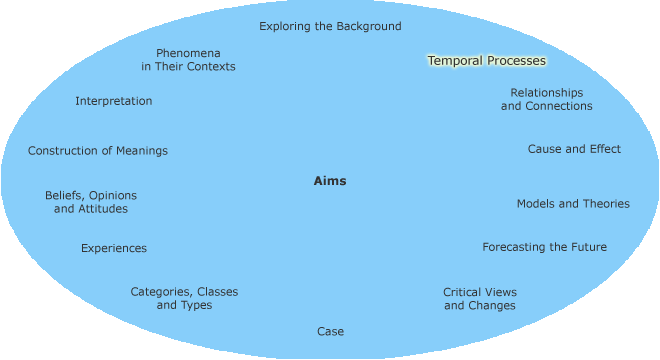Temporal processes

Humanistic research often presents phenomena as series of events and processes in relation to time. Understanding the historical nature of phenomena and the temporal aspects of processes is one of the core areas of humanistic research. The aims of the research may focus on presenting and explaining the historical change of phenomena and processes. You can present temporal processes statistically with Tables and Figures. The chosen time frame can reach far back into the past or can be limited to a very short period of time in which the process has occurred.
Strategies
Research aiming to present the temporal development of processes by examining concrete materials such as text documents, audio recorded interviews, images and objects can be defined as empirical research. This type of research may use either qualitative research or quantitative research. Even though the strategies of qualitative and quantitative research differ greatly, a mixed method of research, combining both strategies is suitable. For example, Figures based on quantitative research can illustrate qualitative research.
A case study enables you to explore the background factors to be researched by focusing on either a particular or small group of research objects. Longitudinal research enables you to explore a process, and its development, over a long period of time. Historical research enables you to research temporal processes in a qualitative way. You can examine temporal processes by conducting a case study focusing on either a single or a small group of phenomena or focus on a larger group of phenomena.
Data Collection
Various methods of data collection enable you to investigate the temporal development of processes. You can use either data collected for previous research by another researcher (existing concrete materials) or collect / produce your own data during the research process.
You need to be aware that an essential point in the process of selecting or producing material is that the material increases the understanding of processes in relation to time.
You can use a variety of research strategies:
Population research is suitable when the quantity of available data on a phenomenon is small. Sampling is suitable when the quantity of available data on a phenomenon is too large for you to analyse all of it. Random sampling enables you to select a small element without bias. Purposive sampling (goal-directed sampling) enables you to select samples that match the aim of the study. For example, archival texts and documents are typical in historical research and are usually available in large quantities. While the majority may be relevant to your research, you can regulate which documents you want to analyse.
You can collect data for research on the temporal processes from archives or through a follow-up study or observation. If you are doing quantitative research, experiment and surveys are suitable ways to collect data.
Data Analysis
Both quantitative analysis and qualitative analysis methods are suitable for analysing the temporal processes.
Descriptive statistical analysis, a form of quantitative analysis, covers several variations of statistical description.
Hermeneutic analysis is a form of qualitative analysis.
Close reading of data is a form of qualitative analysis, enabling you to gain a deep understanding of the phenomenon.
There are also, in different academic fields, various discipline-specific methods which enable you to analyse changes in processes and historical series of events.
Philosophy of Science
Qualitative analysis methods in the humanities are based on interpretivism. Views stressing interpretation in the formation of meanings and subjectivity in meaning-making processes are based on relativism.
Quantitative analysis methods are based on positivism, which emphasises the production of knowledge through exact measuring and use of numeral variables. Views, which emphasize the exactness and correctness of measured knowledge, are based on realism, which views knowledge as objective.
Hermeneutic analysis modes and different types of close reading methods, which are often used in quantitative analysis of temporal processes, are based on the concept of hermeneutics.
